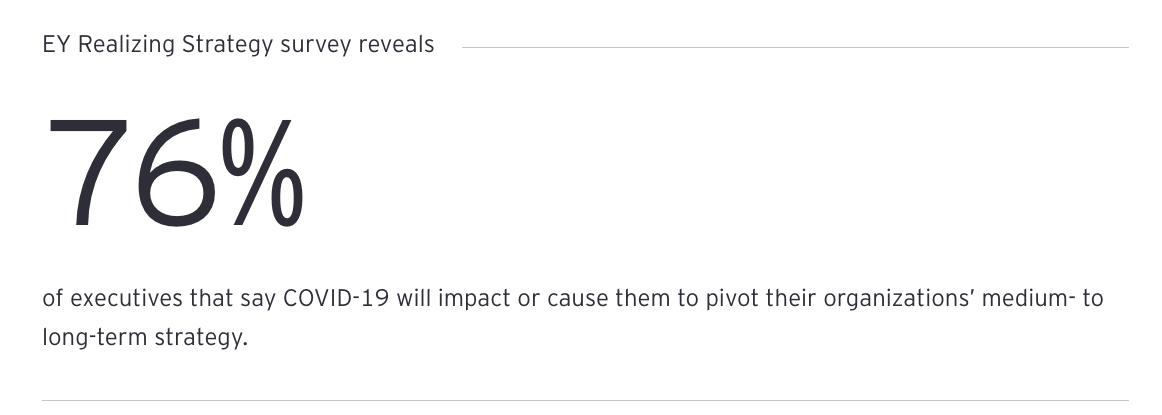Business competition is always a fierce battlefield, but as companies look beyond the COVID crisis, they will almost surely need to change how they devise and execute corporate strategy to outpace disruption and their competition, according to new research from consulting strategy firm EY. In the latest EY Realizing Strategy report, business executives considered the extent to which growing threats have forced companies to revise their approach for planning future business activities.
The study arrives as many executives struggle to respond to a rapidly changing business environment. Lower barriers to entry across many sectors, coupled with a more connected global economy and increased exposure to macro events, have accelerated disruption and reduced the average company survival rate. The study shows that the current speed of innovation requires different ways of shifting resources across the enterprise.
“The rules of yesterday don’t apply to today or tomorrow. Companies have to proactively incorporate disruption into strategy formation or watch their organizations falter,” said Jeff Wray, EY Americas EY-Parthenon strategy leader, in a news release.
Changing the mindset: from shareholder returns to more stakeholders
When thinking through a creative and disruptive strategy, the end audience for companies has fundamentally changed. The former “laser focus” on shareholder returns has widened to prioritize a broader array of stakeholders and values, including customers, employees and suppliers, as well as environmental and social goals.
Sector-specific dynamics often determine degrees of importance among executives.
In financial services, regulatory stakeholder interests carry as much, or more, weight than those of shareholders, according to 78 percent of executives. Meanwhile, 58 percent of consumer products and retail executives place customers’ interests above those of shareholders. Thus, a company’s underlying strategic vision must generally include a focus on sector-specific perspectives.
External threats dominate decision making, spur ‘coopetition’
Companies are learning to build a resilient strategy as their universe of potential competitors expands. Consequently, the number and variety of threats stretch beyond similar organizations to include indirect competitors in adjacent industries and nontraditional competitors in unrelated industries.
Of those companies that underperformed their peers, an overwhelming majority (93 percent) say that unexpected entrants have materially impacted business. At the other end of the spectrum, 64 percent of organizations that have performed materially better say that they were able to anticipate market newcomers, which greatly limited their effect on business.
Viewed through a different lens, many organizations see competition as an opportunity for collaboration. An astonishing 97% address the ever-growing threat matrix by partnering with competitors, enhancing their ability to assess strategic priorities and combat challengers from outside their competitive space. An exploration of this approach found that 56 percent of organizations are most likely to partner with a competitor to overcome traditional barriers, while 43 percent would actively partner with a competitor to enter new markets.
Democratization of strategy empowers more experts to contribute
Strategy formulation now touches more roles than ever as singular top-down management has taken a back seat. Leaders now understand the power of aggregating diverse ideas from experts to solve new challenges. Strategy development, once limited to a small group of thought leaders, now requires input from a larger group of executives empowering expert-led business transformation.
Illustrating this evolution, more than half of those surveyed say that the chief growth officer, the chief transformation officer and the chief sustainability officer now influence the strategy process. It is important to note that a number of those positions were created in only the last five years.
Moving at the ‘speed of thought’ to drive innovation
Ever-accelerating disruption today requires businesses to rewire their thinking to be more agile and innovative, and to reallocate capital more rapidly. Many outperforming businesses say that they actively plan for the emergence of market entrants that use unconventional, yet potentially challenging, business models, with 99 percent saying that they conduct exercises that stress-test their strategic processes. Meanwhile, 63 percent say that they allocate capital for innovative ideas more liberally, as well as adopt more flexible approaches that better adapt to the sheer speed of disruption.
Still, business leaders recognize that too few companies are flexible enough to adapt as rapidly as strategy evolves. About 40 percent of executives say that they plan to meet this challenge through implementing agile practices and processes over the next three years. These include accelerating digitization, increasing the speed of capital allocation decisions, building a culture of innovation and engaging in more inorganic transactions.
“There’s no doubt that, since the 2008 Global Financial Crisis, smart organizations have learned that sitting tight and doing nothing in an economic downturn is not an option, and a creative and evolved strategy is required to be an organization of the future,” explained Juan Uro, EY strategy and transactions principal, in the release. “This study demonstrates not only the resilience which strategy provides in protecting businesses but also providing companies with the backbone needed to thrive in the eventual recovery.”
The EY Realizing Strategy survey gauges how organizations will need to transform to realize strategy in the new decade. The survey was conducted in collaboration with The Economist Intelligence Unit. The report queried 1,000 executives from Europe, North America and Asia from a broad range of industries at companies with more than $1b in revenue. Of those surveyed, there were 400 CEOs, 200 CFOs and 150 chief strategy officers. The sectors represented in the survey included Consumer Products & Retail; Energy & Natural Resources; Financial Services; Health & Life Sciences; Advance Manufacturing & Mobility; and Technology, Media & Telecommunications.











